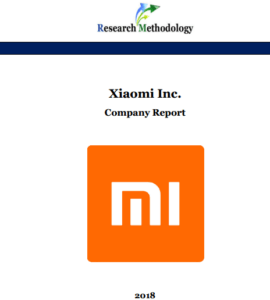Xiaomi Inc. Report

- Published: May 2018
- 9696 Words
- 40 Pages
Xiaomi Inc. is a privately owned electronics and software company founded in 2010 by serial entrepreneur Lei Jun, along with seven other co-founders. The mobile internet company has established its presence in 70 countries and regions and it is among the top 5 in 16 markets. Xiaomi currently employs about 18,000 people. In 2017 Xiaomi generated more than RMB 100 billion revenues and expected to get listed in the Fortune Global 500 list in foreseeable future.
Xiaomi business strategy is based on cost advantage. Moreover, the company gathers and utilizes its large fan base in an efficient manner with positive implications on customer loyalty and the bottom line for the business. An aggressive expansion of ecosystem of products and services is also placed at the core of Xiaomi business strategy.
The mobile internet company has matrix and flat organizational structure. According to framework of Ansoff Growth Matrix, Xiaomi uses all for strategies – market penetration, product development, market development and diversification, in an integrated manner.
Efficient leadership by founder and CEO Lei Jun, impressive rate of growth and cost advantages compared to competition are considered as major strengths associated with Xiaomi. At the same time, the company has noteworthy weaknesses such as low profit margin, lower smartphone capabilities and functionalities compared to major competitors and difficulties of sustaining competitive advantage.
Xiaomi Inc. Report contains the application of the major analytical strategic frameworks in business studies such as SWOT, PESTEL, Porter’s Five Forces, Value Chain analysis and McKinsey 7S Model on Xiaomi. Moreover, the report contains analyses of Xiaomi business strategy, leadership and organizational structure and its marketing strategy. The report also discusses the issues of corporate social responsibility.
1. Executive Summary
2. Business Strategy
3. Leadership
4. Organisational Structure
5. Organizational Culture
6. Xiaomi and Ansoff Matrix
7. SWOT Analysis
7.1 Strengths
7.2 Weaknesses
7.3 Opportunities
7.4 Threats
8. PESTEL Analysis
8.1 Political Factors
8.2 Economic Factors
8.3 Social Factors
8.4 Technological Factors
8.5 Environmental Factors
8.6 Legal Factors
9. Marketing Strategy
9.1 7Ps of Marketing
9.2 Segmentation, Targeting & Positioning
9.3 Marketing Communication Mix
9.3.1 Print and Media Advertising
9.3.2 Sales Promotions
9.3.3 Events & Experiences
9.3.4 Public Relations
9.3.5 Direct Marketing
9.3.6 Personal Selling
10. Porter’s Five Forces Analysis
10.1 Threat of new entrants
10.2 Bargaining power of buyers
10.3 Bargaining power of suppliers
10.4 Threat of substitute products or services
10.5 Rivalry among existing firms
11. Xiaomi Value-Chain Analysis
11.1 Primary Activities
11.1.1 Inbound logistics
11.1.2 Operations
11.1.3 Outbound logistics
11.1.4 Marketing and Sales
11.1.5 Service
11.2 Support Activities
11.2.1 Infrastructure.
11.2.2 Human Resource Management
11.2.3 Technology Development
11.2.4 Procurement
12. McKinsey 7S Model
12.1 Hard Elements
12.2 Soft Elements
13. Xiaomi Ecosystem
14. Corporate Social Responsibility
14.1 CSR Programs and Initiatives
14.2 CSR Criticism
15. Recommendations
List of Figures
Figure 1 Xiaomi business model map
Figure 2 Xiaomi organizational structure
Figure 3 Xiaomi Ansoff Growth Matrix
Figure 4 Xiaomi Porter’s Five Forces
Figure 5 Global market share of leading smartphone vendors
Figure 6 Xiaomi Value Chain Analysis
Figure 7 Xiaomi McKinsey 7S Model
Figure 8 Xiaomi Ecosystem
List of Tables
Table 1 Xiaomi SWOT analysis
Table 2 Xiaomi segmentation, targeting and positioning
Table 3 Xiaomi CSR Programs and Initiatives
Alibaba Group Holding Ltd.
Amazon
Apple
Baidu
Croma
Facebook
Google
HTC
Huawei
Lenovo
LG
Microsoft
Nokia
Oppo
Samsung
Sony
Tencent
Univercell
Vivo
ZTE
Why this report is so cheap?
1. Reports offered in this portal are produced by a small group of academic writers headed by John Dudovski.
2. Our reports are shorter compared to reports produced by large research companies. Company reports are produced to assist with academic works of business students in particular. Therefore, all points that do not relate to academic needs of business students are left out.
3. We do not have huge fixed expenses large research companies do, thus, we are able to deliver reports for a little cost.
How do I receive the report?
After completing the payment you will receive a link to the e-mail related to your Pay Pal account or the e-email you entered when specifying bank details. You can download the report via this link. The report is downloaded in PDF format. The link will stay active for 7 days.
How can I use the report to complete my academic assignment/research?
Reports offered by research-methodology.net are professionally written samples in their respective areas. Reports are intended to be used as guides and sources of secondary data for reference purposes.
How to reference this report?
You can reference this report in the following manners:
Harvard Referencing System
Dudovskiy, J. (2018) Xiaomi Inc. Company Report, UK: Research Methodology, Available from: https://research-methodology.net/xiaomi-inc-report/
APA Referencing System
Dudovskiy, J. (2018). Xiaomi Inc. Company Report, Retrieved from https://research-methodology.net/xiaomi-inc-report/
Vancouver Referencing System
Dudovskiy J. Xiaomi Inc. Company Report. UK: Research Methodology, 2018, [cited ‘the date you used the report’] Available from: https://research-methodology.net/xiaomi-inc-report/
I did not receive the link/I can not download the report?
If you have any difficulties with downloading reports you have purchased please e-mail us the details of your purchase. We will send the report to you as an e-mail attachment shortly.
- Published: May 2018
- 9696 Words
- 40 Pages




